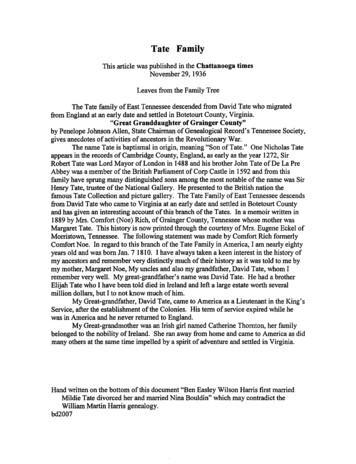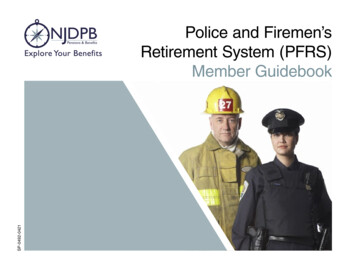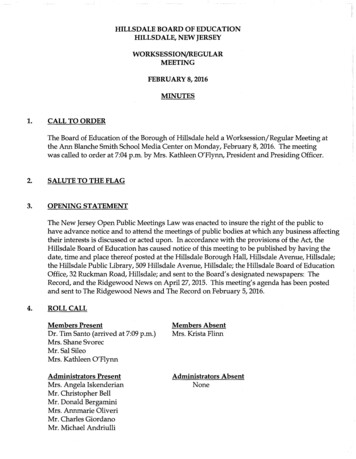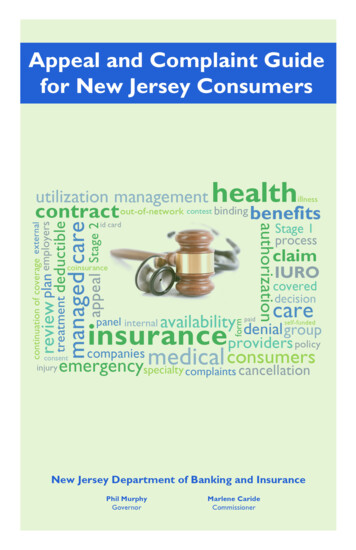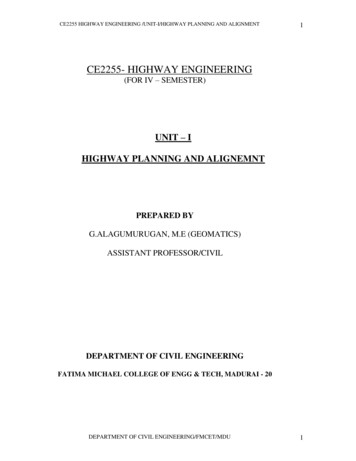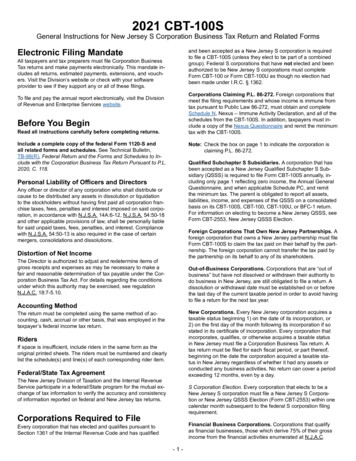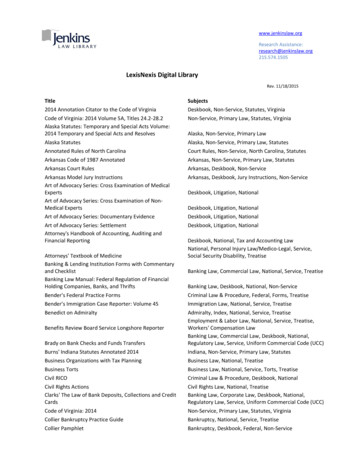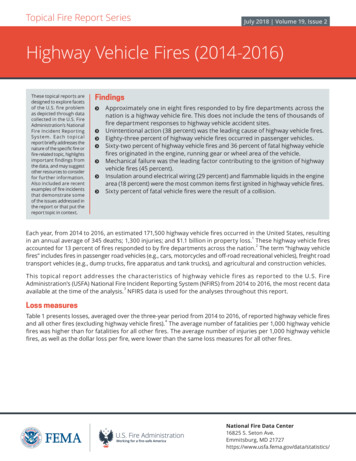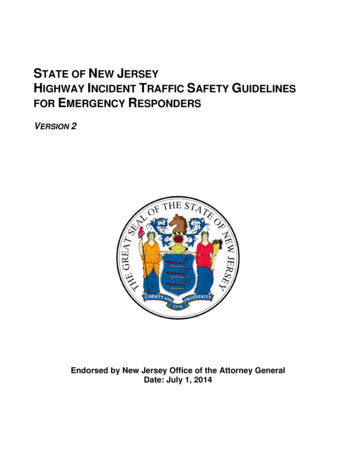
Transcription
STATE OF NEW JERSEYHIGHWAY INCIDENT TRAFFIC SAFETY GUIDELINESFOR EMERGENCY RESPONDERSVERSION 2Endorsed by New Jersey Office of the Attorney GeneralDate: July 1, 2014
AcknowledgementsNew Jersey Career Fire Chief’s AssociationNew Jersey Division of Fire SafetyNew Jersey Department of Transportation – Transportation Systems ManagementNew Jersey State Fire Chief’s AssociationNew Jersey State First Aid CouncilNew Jersey State Police Highway Traffic Safety UnitNew Jersey State Police Incident Management UnitDelaware Valley Regional Planning Commission
TABLE OF CONTENTS1Introduction .12Definition of Terms .Temporary Traffic Control Zone Diagrams .243Incident Management .64Roles and Responsibilities .75Recommended Equipment .96General Safety and Risk Management .97Incident Response . 118Arriving on Scene . 129Traffic Control . 1310Demobilization . 1611Guideline Maintenance and Updates. 1611.1 Record of Changes. 1711.2 State of New Jersey Highway Incident Traffic Safety Guidelinesfor Incident Responders Feedback Committee . 1712Feedback and Resolution Process . 18APPENDICESAManual on Uniform Traffic Control Devices Chapter 6I.Control of Traffic Through Traffic Incident Management Areas . A1BTowing and Recovery Association of AmericaVehicle Identification Guide . B1
State of New Jersey Highway Incident Traffic Safety Guidelines for Emergency Responders1INTRODUCTIONThe purpose of this document is to provide uniform operational guidelines to ensure safeoperations by emergency responders dispatched to incidents on limited access highways andother roadways as applicable in the State of New Jersey. These operational guidelines wereformulated based on nationally recognized practices, with guidance from those agencies listedunder Acknowledgements. Input was received from representatives of those agencies listedunder the State of New Jersey Highway Incident Traffic Safety Guidelines for EmergencyResponders Feedback Committee, and the document was endorsed by the New Jersey Officeof the Attorney General. This document should be used by emergency responders as aguideline for decision-making. The decisions can be modified as necessary to address existingonsite conditions.Guidelines Mission: Provide a sustainable, multi-disciplined, and consistent traffic incidentmanagement program to promote: first responder safety; safe, quick clearance practices; andprompt, reliable incident communication.These guidelines identify safe vehicle positioning, common general safety, and onsite practicesfor all emergency responders. It provides guidance for maximum protection and safety for allemergency responders operating at limited access highway incidents and other roadways Asapplicable. These guidelines also identify the need to provide mobility for the motoring public.All emergency responders should adhere to the standards set forth in the Manual on UniformTraffic Control Devices (MUTCD), Chapter 6I, which is listed in Appendix A. All emergencyresponders should understand and appreciate the special hazards and high risk that personnelare exposed to when operating at highway related incidents with motor vehicle traffic, highvehicle speeds, adverse weather conditions, heavy trucks, and exposure to motorists withvarying degrees of ability, with possible vision, alcohol, and drug impairment. All emergencyresponders shall understand that the objective is to get onto the highway, perform their duties,and get off the highway as quickly and efficiently as possible. This will reduce high-riskexposure and help to get traffic patterns back to normal. Emergency responders should alwaysoperate within a protected environment at any type of incident on or near a highway, and whenexposed to motor vehicle traffic.The guidelines in this document are general since they cannot cover all incidents or unique sitespecific conditions. This document is not intended to be a textbook, nor a substitute for training,technical knowledge, experience, or effective judgment. Local or geographic conditions maynecessitate the need for additional sections to this document.In order to manage highway incidents efficiently and safely on a consistent basis, it is importantthat emergency responders have an awareness of expected behavior from other respondingagencies. All emergency responders should make every effort to increase communication andcooperation at an incident to reduce points of conflict and to better understand each agency’sconcerns. Managing a highway incident and any related problem is a team effort. It is not aquestion of “who is in charge” but “who is in charge of what.”Version 2, Endorsed July 20141
State of New Jersey Highway Incident Traffic Safety Guidelines for Emergency RespondersObjectives of the guidelines set forth in this document follow recommended strategies of theNational Unified Goal (NUG) of Traffic Incident Management. The NUG is a unified nationalpolicy developed by major national organizations representing traffic incident responders, underthe leadership of the National Traffic Incident Management Coalition. The mission of thisdocument are consistent with the three goals of the NUG: promotion of responder safety; safe,quick clearance; and prompt, reliable, interoperable communications.Training on these guidelines is necessary and will be offered throughout the state. The State ofNew Jersey Highway Incident Traffic Safety Training Program has been approved by theFederal Highway Administration through their Strategic Highway Research Program (SHRP 2).2DEFINITION OF TERMSThe following terms shall be used during incident operations, post incident analyses, andtraining activities related to working in or near moving traffic:Activity Area – an area comprised of the Buffer Space and the Incident Space.Advance Warning Area– an area established upstream of the incident to alert drivers ofthe upcoming incident scene. This area should be a high priority for emergencyresponders. Placement of advance warning devices may need to be adjusted forsituations near a curve, corner, hill, or other reduced visibility situations.Blocker Vehicle – the initial on-scene emergency vehicle, preferably a fire apparatus,positioned on an angle to the lanes of traffic creating a physical barrier betweenupstream traffic and the Incident Space where responders are working. This includesusing the vehicle to “block to the left” or “block to the right”.Buffer Space –the empty, unoccupied space or distance between the Transition Areaand the Incident Space.Downstream – the area past the incident in the direction of normal traffic flow as ittravels away from the incident space.Emergency Responder – Fire, Police, EMS, transportation agency, and any otherpersonnel dispatched to an emergency scene.Incident – any non-recurring event that causes a reduction of roadway capacity due tomotor vehicle crashes, vehicle fires, natural disaster, or other unplanned event thataffects or impedes the normal flow of traffic.Version 2, Endorsed July 20142
State of New Jersey Highway Incident Traffic Safety Guidelines for Emergency RespondersIncident Space –the area contained in the Activity Area which includes the incident andthe necessary space around the incident required to manage the event, includingvehicles and personnel.Law Enforcement – New Jersey State Police or other law enforcement agency withjurisdictional authority.Limited Access Highway – designation of a highway with limited access points.MUTCD – The Manual on Uniform Traffic Control Devices, published by the FederalHighway Administration (FHWA) under 23 Code of Federal Regulations (CFR), Part655, Subpart F.Off-ramp – exit from the highway.On-ramp – entrance to the highway.Protected Space – the space not occupied by responders or response vehicles betweenthe blocking vehicle and the incident. A Blocker Vehicle should be positioned asufficient distance in advance of responders to absorb contact by an errant vehicle.Shadow Vehicle – the second due fire apparatus or other emergency responder vehicle,which positions upstream of the Blocker vehicle at an angle.Taper – the action of directing several lanes of traffic into fewer or more lanes utilizingtraffic control devices. This action should be used prior to the Buffer Space, and mayalso be used in the Termination Area.Temporary Traffic Control Zone –defined by the MUTCD as an area of highway whereroad user conditions are changed because of a work zone or an incident through theuse of temporary traffic control devices, uniformed law enforcement officers, orauthorized personnel.Termination Area – the area used to notify drivers that the Traffic Incident ManagementArea is ending and they may resume normal driving.Traffic Incident Management Area – this area is a type of Temporary Traffic ControlZone and extends from the first warning device to an area where the moving trafficreturns to original traffic patterns and is clear of the incident. Consideration should begiven to include the area which is part of the police investigation. This area has fourmain components: Advance Warning Area, Transition Area, Activity Area andTermination Area.Version 2, Endorsed July 20143
State of New Jersey Highway Incident Traffic Safety Guidelines for Emergency RespondersTransition Area – the area/lane of roadway where approaching motorists change theirspeed and position to comply with the traffic control measures established at anincident scene.Upstream – the area prior to the incident in the direction of normal traffic flow as thevehicles approach the Traffic Incident Management Area.The following diagrams illustrate typical components of a Temporary Traffic Control Zoneand example incident situations.Version 2, Endorsed July 20144
State of New Jersey Highway Incident Traffic Safety Guidelines for Emergency RespondersVersion 2, Endorsed July 20145
State of New Jersey Highway Incident Traffic Safety Guidelines for Emergency Responders3INCIDENT MANAGEMENTResponders to highway incidents will utilize a National Incident Management System (NIMS)compliant command structure. As defined by FEMA, NIMS is a comprehensive, nationalapproach to incident management that is applicable at all jurisdictional levels and acrossfunctional disciplines. It is intended to: Be applicable across a full spectrum of potential incidents, hazards, and impacts;regardless of size, location, or complexity.Improve coordination and cooperation between public and private entities in a variety ofincident management activities.Provide a common standard for overall incident management.Incidents requiring the response of multiple stakeholders will be managed via a UnifiedCommand. As such, each responding discipline will send a representative to the UnifiedCommand Post, where they will work cooperatively and within their respective areas ofexpertise to safely and effectively mitigate the incident. Decisions will be communicatedamongst all stakeholder representatives to ensure coordination of efforts.The designated law enforcement member on scene will serve in the role of IncidentCommander, and will have the final say in any disputes which arise within the unified commandstructure.In conformance with NIMS, responders will typically be assigned to one of the followingbranches: Fire Branch (Rescue, HazMat, Suppression); Emergency Medical Services Branch(Triage, Treatment, Transport, Rehab); and Police Branch (New Jersey State Police (NJSP),other law enforcement, New Jersey Department of Transportation (NJDOT), other transportationagencies, towing and recovery).3.1The first arriving emergency responder will establish command of the incident andremains in control until command is transferred or the incident is stabilized andterminated.3.2If law enforcement arrives on an established scene, they shall interface with the IncidentCommander for an incident briefing and the transfer of command. While still maintainingoverall incident scene responsibility, the law enforcement Incident Commander maydesignate incident operations to another public safety agency in order to effectivelymanage and coordinate incident resources.Version 2, Endorsed July 20146
State of New Jersey Highway Incident Traffic Safety Guidelines for Emergency Responders4ROLES AND RESPONSIBILITIESThe following is an outline of typical roles and responsibilities of emergency responders who aredispatched to highway incidents. It is understood the listed roles and responsibilities may varybased on incident needs.4.1Common ResponsibilitiesTypical incident management responsibilities applicable to all branches include:(a)Protect the incident scene(b)Perform first responder duties(c)Assume role of Incident Commander, if appropriate(d)Support unified command(e)Clear minor incidents(f)Follow bloodborne pathogens protocol(g)Wear appropriate Personal Protective Equipment (PPE), including Safety Vests(h)Preserve evidence(i)Be visible at all times4.2Emergency Medical Services BranchThe primary responsibilities of EMS are the triage, treatment, and transport of victims.Additional incident management responsibilities include:(a)Provide medical treatment to those injured at the incident scene(b)Determine destination and transportation requirements for injured victims(c)Coordinate evacuation with fire, police, and ambulance or airlift(d)Transport victims for additional medical treatment(e)Provide medical monitoring and rehabilitation for emergency responders4.3Fire BranchFire and rescue services are provided by fire departments and HazMat agencies.Additional incident management responsibilities include:(a)Rescue/extricate victims(b)Extinguish fires(c)Stabilize and render safe crash damaged vehicles(d)Assess incidents involving a hazardous materials release(e)Contain or mitigate a hazardous materials release(f)Mitigate minor fluid spills(g)Establish and monitor Temporary Medevac Landing ZonesVersion 2, Endorsed July 20147
State of New Jersey Highway Incident Traffic Safety Guidelines for Emergency Responders4.4Police Branch4.4.1 Law EnforcementApplicable law enforcement agencies have jurisdiction over highway incidents.Additional incident management responsibilities include:(a)Serve as Incident Commander(b)Secure incident scene(c)Assist responders in accessing the incident scene(d)Establish emergency access routes(e)Control arrival and departure of incident responders(f)Police perimeter of incident scene and impact area(g)Conduct incident investigation(h)Establish Temporary Traffic Control Zone(i)Perform traffic control(j)Remain at the incident scene until the tow truck or other last responder has left thescene, unless the highway agency provides that coverage4.4.2 Transportation AgencyThe applicable transportation agency is responsible for establishing traffic control.Additional incident management responsibilities include:(a)Monitor Traffic Operations(b)Perform incident detection and verification(c)Establish Temporary Traffic Control Zone(d)Implement traffic control strategies and provide supporting resources(e)Disseminate motorist information(f)Assess and direct incident clearance activities(g)Develop and operate alternate routes(h)Assess and perform emergency roadwork and infrastructure repair(i)Remain at the incident scene until the tow truck or last responder has left thescene, unless law enforcement provides that coverage4.4.3 Towing and RecoveryTowing and recovery services are responsible for the safe and efficient removal ofwrecked or disabled vehicles, and debris from the incident scene. Appendix B includesthe Towing & Recovery Association of America (TRAA) Vehicle Identification Guide toassist in providing information needed to correctly dispatch towing and recovery units.Towing and recovery operators shall respond under guidelines established in the NJSPSOP for vehicle towing (F56).Additional incident management responsibilities include:(a)Evaluate scene safety with IC, discussing recovery procedures(b)Provide technical assistance/information to other responding stakeholdersVersion 2, Endorsed July 20148
State of New Jersey Highway Incident Traffic Safety Guidelines for Emergency Responders(c)(d)(e)(f)(g)(h)(i)(j)5Mitigate minor fluid spillsApply absorbents and remove debris/spilled fluids from the roadway, and properlydispose of, when directed by IC under the guidelines of State Statue Title 39:4–56.8Perform recovery by re-aligning the vehicle to tow truck, not tow truck to vehicle,using snatch blocks or other techniques, when able to do so safelyPerform recoveries in one lane, if possible, and load vehicle for transportClean up debris and used absorbents. Do not place debris and absorbents in thevehicleReturn roadway to pre-incident condition as well as possibleCheck in with IC prior to departing the sceneTransport occupants of the vehicle to a safe location after the vehicle is removedfrom the roadwayRECOMMENDED EQUIPMENTAll dispatched responding personnel must wear ANSI Class II (or higher) Safety Vests. Incompliance with the MUTCD, and where applicable, agencies responding to incidents shouldhave the following equipment.5.1A minimum of six (6) NJDOT approved reflective traffic cones;5.2A minimum of one (1) case of traffic flares or strobes;5.3A lighted arrow stick or sign board;5.4National Fire Protection Association 2009 Edition, NJDOT, or other agency approvedreflective striping to the rear and sides of the appropriate emergency response vehicles;5.5A minimum compliment of Basic First Aid equipment;5.6A 48” x 48” retro-reflective pink sign stating “Emergency Scene Ahead”.6GENERAL SAFETY AND RISK MANAGEMENTResponders to highway incidents must maintain a constant awareness of the inherent danger ofoperating on limited access highways. While completely closing the highway whenever anincident occurs may seem the safest option, it can cause a myriad of problems andcomplications: The number of personnel needed to safely and effectively close the highway or roadway.Version 2, Endorsed July 20149
State of New Jersey Highway Incident Traffic Safety Guidelines for Emergency Responders The greatly increased chance of secondary crashes, both on the affected highway and onsecondary roads not designed for the increased traffic volume.The likely delay for additional emergency units attempting to access the incident scene.Significant traffic congestion in a large geographic area, impeding responses to additionalemergency incidents which may occur.Therefore, police and other emergency responders must work cooperatively to employ thenecessary traffic diversions to establish a safe work zone for responders, without unnecessarilyrestricting the flow of traffic through the area.Each responder at an incident must be constantly aware of his or her personal safety. Whiletraffic control devices and visibility enhancing garments will increase your safety, they will notprotect you from a driver who loses control of their vehicle and/or is not paying attention to theroad. Therefore, your greatest protection is to keep a physical barrier (blocker vehicle, guiderail,crash vehicles, etc.) between you and moving traffic whenever possible.The following are additional protective measures you can take to maximize your protection at anincident scene. Be safe. Act safe.6.1In accordance with Federal Regulation 23 CFR 634, all emergency workers operating ona highway who are exposed to traffic shall wear a Class II or higher vest complying withANSI/ISEA 107, 2004 or 2006 or a Public Safety Vest complying with ANSI/ISEA 207,2006. Firefighters or other emergency responders engaged in emergency operations thatdirectly expose them to flame, fire, heat, and/or hazardous materials are not required towear a vest, provided they are attired in retro-reflective turn-out gear that is specified andregulated by other organizations, such as the National Fire Protection Association.6.2Notwithstanding the visibility requirements described above, fire department membersare expected to wear full Personal Protective Equipment (coat, pants, helmet) whileoperating on the highway. As noted above, an approved Class II vest must be worn overthe coat (unless the above described exemption criteria is met). The IC may allowfirefighters to remove their coats after the hazard has been mitigated, however, the ClassII vest must still be worn.6.3Responders shall never operate in a live lane. Crossing a live lane should be done withextreme caution and should be avoided when possible.6.4Hose lines/equipment should be deployed from the protected, downstream side (oppositelive traffic lanes) of emergency vehicles whenever possible.6.5Do not enter or exit apparatus near or in live lanes of traffic.6.6Do not drive against the flow of traffic without law enforcement approval and confirmationthat traffic has been stopped.Version 2, Endorsed July 201410
State of New Jersey Highway Incident Traffic Safety Guidelines for Emergency Responders6.7Use designated entrances and exits. Do not use median turnarounds unless there is a lifethreat or other extenuating circumstances.6.8Shut down forward facing emergency lights to reduce opposite direction incidents.6.9Limit the amount of equipment on the roadway, thus reducing your liability exposure. Riskvs. Need.6.10Always communicate, coordinate, cooperate, be professional, and work within theframework of unified command.6.11Ensure all members are aware of and trained on these guidelines.7INCIDENT RESPONSEResponse to limited access highway incidents should be made by the agency that has thesafest and most efficient access to the incident. This may require agreements to be executedso a municipality can cover incidents that are in another municipality or geographical area.Consideration should be given to using mutual aid to cover the opposite direction of thehighway. Mutual aid should be considered to share and provide an adequate response andadequate resources. Once the location and scope of the incident is determined, only essentialvehicles should be committed to respond. All other apparatus should be returned or assigned tostaging. It is important to note that if emergency responders are cancelled by law enforcementwhile en route to any highway assignment, they shall go available and return.7.1Only official vehicles will be permitted on the highway. Under no circumstances willpersonal vehicles respond to incidents on any limited access highways.7.2A sufficient crew of emergency responders is recommended for units responding toincidents to limit the number of apparatus on scene.7.3Companies may be assigned responsibility for a specific area of the highway, and maybe directed to enter the highway via a designated ramp. Absent extenuatingcircumstances, or specific orders to the contrary, companies will utilize their assignedentry ramp whenever responding to incidents.7.4As a general rule, full size fire apparatus should utilize normal entrances and exits toreverse their direction of travel. Use of the median or paved U-Turns should be reservedfor life threatening emergencies and extenuating circumstances.Version 2, Endorsed July 201411
State of New Jersey Highway Incident Traffic Safety Guidelines for Emergency Responders7.5Emergency responding units should utilize normal entrances and exits to reverse theirdirection of travel. Use of the median or paved U-Turns should be reserved for lifethreatening emergencies and extenuating circumstances.7.6In the absence of other options, it may be necessary for emergency vehicles to travelagainst the normal traffic flow to access an incident scene. No units or vehicles willemploy this maneuver unless and until they receive specific approval from lawenforcement and confirmation that traffic flow has been stopped. Once approval isreceived, the emergency vehicle shall proceed with extreme caution utilizing the shoulderportion of the roadway if possible.7.7Communicate with the appropriate transportation agency’s regional traffic operationscenter or dispatch center to assist with detection and verification of the incident location.8ARRIVING ON SCENE8.1The first arriving emergency responder will establish command and provide an arrivalreport with the following information:(a)Location of the incident (direction of travel, milepost, landmark, waterway, etc.)(b)Lanes affected by the incident(c)Number of vehicles involved(d)Vehicle condition (on fire, overheat, occupied, entrapment, overturned)(e)Best access for responding units (left shoulder, right shoulder, etc.)8.2A detailed size-up should be conducted as quickly as possible. Based on the size-up, adetermination will be made regarding the resources needed to handle the incident. Unitsnot needed should be directed to staging or recalled.8.3Standard practice will be to position emergency response vehicles in such a manner thatbest protects the incident space and passing motorists.8.4Consideration should be given to traffic flow and to providing an avenue for additionalresources to access the incident space.8.5When possible, crew members should enter/exit their units on the side opposite thetraffic flow. Emergency responders should always check for approaching traffic beforeexiting their vehicle.8.6The magnitude of the incident should be estimated, within the first fifteen (15) minutes ofarrival, using the criteria set below:Minor – 30 minutes or lessIntermediate – 30 minutes to 2 hours (contact Highway Agency)Version 2, Endorsed July 201412
State of New Jersey Highway Incident Traffic Safety Guidelines for Emergency RespondersMajor – more than 2 hours (contact Highway Agency)All incidents should be updated every 15-30 minutes.8.7Emergency responders should always be aware of their visibility to oncoming traffic andtake measures to move the traffic incident as far off the traveled highway as possible orto provide for appropriate warning. Emergency vehicles should be safe-positioned in sucha manner as to optimize traffic flow through the incident scene. All subsequent arrivingemergency vehicles should be positioned as to not interfere with the establishedtemporary traffic flow.8.8EMS units should routinely be positioned downstream of the incident, within the incidentspace.8.9If a second fire apparatus responds to the scene as a shadow vehicle, it should safeposition at least 50 feet upstream of the blocker vehicle, to help ensure an adequatebuffer zone. The crew in the shadow vehicle shall abandon the vehicle and report to theincident space. The shadow vehicle assumes a fend-off position to deflect any highspeed impact that would otherwise crash into the incident space.8.10Unit operators shall cancel any warning lights, which impair the vision of approachingtraffic (i.e. headlights, spotlights, clear warning lights).8.11Position emergency vehicles on the same side of the roadway as the incident.9TRAFFIC CONTROLEmergency responders shall control oncoming traffic prior to turning their attention to theincident. Understanding that there is no absolute means to protect emergency responders at thescene of an incident, responders are urged to constantly keep in mind the “four guidingprinciples” when operating in or near moving traffic. Recognizing the following principles willincrease the margin of safety.Provide Advance WarningUse traffic control devices such as signs, other emergency vehicles, or any otherappropriate device that will warn or direct motorists away from an approaching incident.Protect the ScenePosition vehicles and traffic control devices in such a way that allows for adequate spacebetween the point where the traffic is diverted and the actual incident space. Fireapparatus should position in a manner that best protects the incident space. SuchVersion 2, Endorsed July 201413
State of New Jersey Highway Incident Traffic Safety Guidelines for Emergency Responderspositioning affords protection to responders from the hazards of working in or near motorvehicle traffic.Be VisibleAll responders operating at an incident with moving traffic shall wear highly visible, highlyreflective garments to increase the ability of motorists to see the emergency respondersduring day and night operations.Protect YourselfResponders should make every effort to keep a physical barrier between themselves andmoving traffic. If engaged in emergency activities, try to position a blocker vehiclebetween you and moving traffic. If standing-by at a scene, sit inside your vehicle, or standbehind the guide rail. The less time you’re exposed to moving traffic, the safer you are!9.1Traffic control is primarily the responsibility of applicable law enforcement or highwayauthorities.9.2If the above agencies are not present, it is the responsibility of initial responders toestablish a safe Traffic Incident Management Area. Traffic cones, flares and/oremergency vehicles may be used for this purpose, un
State of New Jersey Highway Incident Traffic Safety Guidelines for Emergency Responders Version 2, Endorsed July 2014 3 Incident Space -the area contained in the Activity Area which includes the incident and the necessary space around the incident required to manage the event, including vehicles and personnel.
